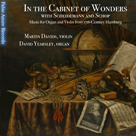

Martin Davids & David Yearsley: In the Cabinet of Wonders
False Azure Records
Following his debut False Azure Records release Handel's Organ Banquet, organist David Yearsley returns with violinist Martin Davids for a collection honouring the rapturous music organist-composer Heinrich Scheidemann (c. 1595-1663) and municipal violinist Johann Schop (c. 1590-1667) created in seventeenth-century Hamburg. Three hundred years might have elapsed, but the sounds presented on In the Cabinet of Wonders are, well, wondrous indeed and in no way out-of-date. With Yearsley playing Munetaka Yokota's 2011 Baroque organ at Cornell University's Anabel Taylor Chapel, the fourteen performances, recorded across two days in January 2023, are no less engaging today than they would have been in Scheidemann and Schop's time.
According to Yearsley, the early collaborators were a major attraction in what was then Germany's biggest city, and the two enthralled listeners when they played from the organ gallery of St. Catherine's church. In his own performances, Yearsley equals the orchestral palette achieved by Scheidemann, and Davids does the same in playing with the same kind of vibrancy Schop brought to his own. As Yearsley notes, Schop and Scheidemann were renowned for the captivating beauty of their duets but also for lifting the spirits of the townsfolk. Apparently much of their playing was improvised, but the notated accounts of their music-making that have survived enable like-minded practitioners such as Yearsley and Davids to introduce today's listeners to the material and prevent it from becoming music familiar to musicological historians only.
The material's alternately credited to Schop and Scheidemann, the violinist's published in Hamburg in the 1630s and the organist's keyboard music left in manuscript form and preserved by Caspar Calvör. As Yearsley clarifies, Schop's music for violin and continuo appeared in a two-volume Amsterdam publication called ‘t Uitnemend Kabinet (the Sublime Cabinet), which explains, in part, the album title. The combination of Davids' singing violin and Yearsley's organ is a thing of beauty, especially when the two effect throughout a carefully calibrated balance.
A stately rendition of Schop's “Intrada à 5” sets a magnificent tone, whether it be the musicians sweetly voicing unison lines or engaging in call-and-response (as they also rhapsodically do during Scheidemann's “Canzon in G”). From ‘t Uitnemend Kabinet comes a rather more melancholy expression, “Nasce la pena mia” (“My torment begins …”), a madrigal the violinist based on a vocal setting by Alessandro Striggio. A florid Scheidemann treatment of Giovanni Bassani's “Dic nobis Maria” (“Tell us, Mary [what you saw]”) is memorable, and Schop's John Dowland-inspired rendering of “Lachrime Pavaen” is affecting too when the performance is distinguished by Davids' expressive playing. He and the organist show themselves to be as apt as improvisers when they execute their brief “Intonatio” with characteristic poise. The duo also deliver a fantasy on the hymnal chorale “Werde munter, mein Gemüte" (“Be cheerful, my soul”), which boasts a melody later used by J. S. Bach in the well-known cantata movement known as “Jesu, Joy of Man's Desiring.”
Davids is a wonder (his magnificent runs in “Nasce la pena mia” exemplify his artistry, as does his unaccompanied presentation of Schop's “Præludium”), and Yearsley excels as his always supportive partner. While the Anabel Taylor Chapel instrument affords him a huge range of colour possibilities (see the solo passage in Scheidemann's “Galliarda ex D,” for example), the organist admirably resists the urge to overembellish and steal the spotlight from his partner (he doesn't need to either when a setting such as Scheidemann's “Englische Mascarada” is scored for organ alone). It's worth mentioning that the two didn't just set out to replicate the music their counterparts created but, as Yearsley reports, instead “granted [themselves] a good measure of interpretative license in expanding on and arranging this music—treating these pieces as templates rather than as works.” That, in a very real sense, makes In the Cabinet of Wonders as much a collection of new music as an historical document of material from centuries ago.April 2025